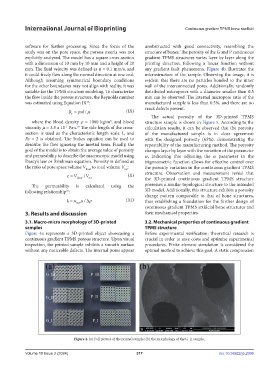Page 325 - IJB-10-2
P. 325
International Journal of Bioprinting Continuous gradient TPMS bone scaffold
software for further processing. Since the focus of the unobstructed with good connectivity, resembling the
study was on the pore space, the porous matrix was not structure of bones. The porosity of the G and P continuous
explicitly analyzed. The model has a square cross-section gradient TPMS structures varies layer by layer along the
with a dimension of 10 mm by 10 mm and a height of 20 printing direction, following a linear function without
mm. The fluid velocity was defined as u = 0.1 mm/s, and any gradient fault phenomena. Figure 4b illustrates the
it could freely flow along the normal direction at one end. microstructure of the sample. Observing the image, it is
Although assuming symmetrical boundary conditions evident that there are no particles bonded to the inner
for the other boundaries may not align with reality, it was wall of the interconnected pores. Additionally, randomly
suitable for the TPMS structure modeling. To characterize distributed micropores with a diameter smaller than 0.5
the flow inside the porous structure, the Reynolds number mm can be observed. The internal micropore ratio of the
was estimated using Equation IX : manufactured sample is less than 0.5%, and there are no
37
R pul / (IX) crack defects present.
e
The actual porosity of the 3D-printed TPMS
where the blood density ρ = 1080 kg/m , and blood structure sample is shown in Figure 5. According to the
3
viscosity µ = 3.5 x 10 Pa·s. The side length of the cross- calculation results, it can be observed that the porosity
38
-3
section is used as the characteristic length scale L, and of the manufactured sample is in close agreement
Re = 2 is obtained. The Stokes equation can be used to with the designed porosity (65%), demonstrating the
describe the flow ignoring the inertial term. Finally, the repeatability of the manufacturing method. The porosity
goal of the model is to obtain the average value of porosity changes layer by layer with the variation of the parameter
and permeability to describe the macroscopic model using ω, indicating that adjusting the ω parameter in the
Darcy’s law or Brinkman equation. Porosity is defined as trigonometric function allows for effective control over
the ratio of pore space volume V to total volume V : the porosity variation in the continuous gradient TPMS
fluid tot
V fluid / V tot (X) structure. Observation and measurement reveal that
the 3D-printed continuous gradient TPMS structure
The permeability is calculated using the possesses a similar topological structure to the intended
following relationship : 3D model. Additionally, this structure exhibits a porosity
39
change pattern comparable to that of bone structures,
k u / (XI) thus establishing a foundation for the further design of
out
continuous gradient TPMS artificial bone structures and
3. Results and discussion their mechanical properties.
3.1. Macro-micro morphology of 3D-printed 3.2. Mechanical properties of continuous gradient
samples TPMS structure
Figure 4a represents a 3D-printed object showcasing a Before experimental verification, theoretical research is
continuous gradient TPMS porous structure. Upon visual crucial in order to save costs and optimize experimental
inspection, the printed sample exhibits a smooth surface procedures. Finite element simulation is considered the
without any noticeable defects. The internal pores appear optimal method to achieve this goal. A static compression
Figure 4. (a) Full picture of the printed sample; (b) the morphology of the G_II sample.
Volume 10 Issue 2 (2024) 317 doi: 10.36922/ijb.2306

